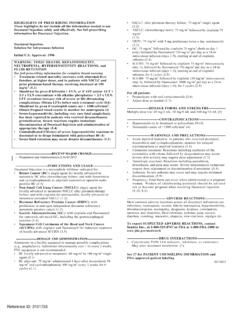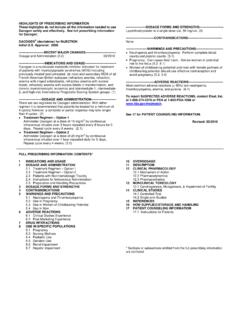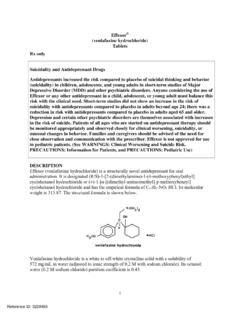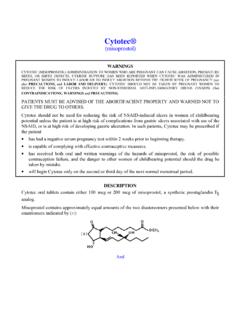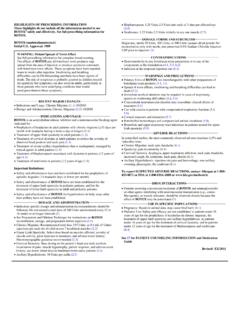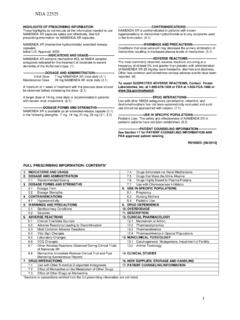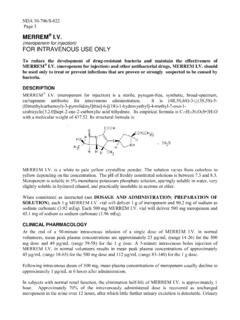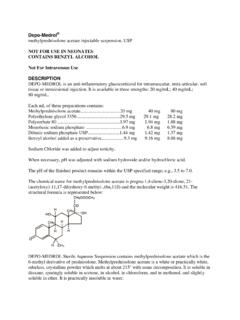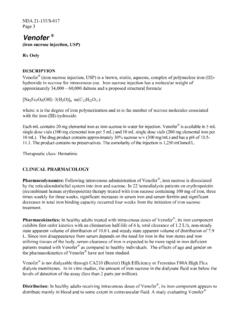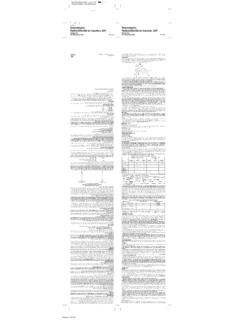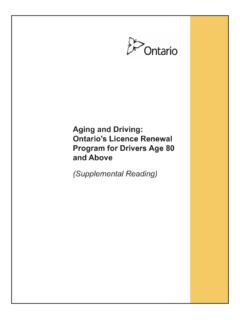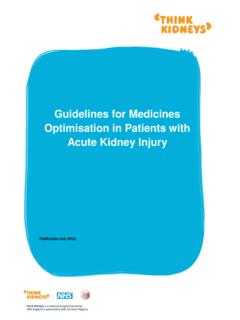Transcription of Diphenhydramine Hydrochloride Injection
1 HH+Cl-COCH2CH2N(CH3)2 Diphenhydramine Hydrochloride Injection , USPD iphenhydramine Hydrochloride Injection , USPD iphenhydramine Hydrochloride Injection , USPRx OnlyDESCRIPTIOND iphenhydramine Hydrochloride is an antihistamine drug having the chemical name 2-(Diphenylmethoxy)-N,N-dimethylethylami ne Hydrochloride . It occurs as a white, crystalline powder, is freely soluble in water and alcohol and has a molecular weight of The molecular formula is C17H21NO HCl and the struc-tural formula is as follows: Diphenhydramine Hydrochloride in the parenteral form is a sterile, pyrogen-free solution.
2 Each mL con-tains a concentration of 50 mg of Diphenhydramine Hydrochloride and water for Injection , for intra-muscular or intravenous use. The solution for paren-teral use has been adjusted to a pH between 4 and with either sodium hydroxide or hydrochloric PHARMACOLOGYD iphenhydramine Hydrochloride is an antihistamine with anticholinergic (drying) and sedative side effects. Antihistamines appear to compete with histamine for cell receptor sites on effector Hydrochloride in the injectable form has a rapid onset of action.
3 Diphenhydramine Hydrochloride is widely distributed throughout the body, including the CNS. A portion of the drug is excreted unchanged in the urine, while the rest is metabolized via the liver. Detailed information on the pharmacokinetics of Diphenhydramine Hydrochloride Injection is not AND USAGED iphenhydramine Hydrochloride in the injectable form is effective in adults and pediatric patients, other than premature infants and neonates, for the following conditions when Diphenhydramine hydro-chloride in the oral form is.
4 For amelioration of allergic reactions to blood or plasma, in anaphylaxis as an adjunct to epinephrine and other standard measures after the acute symptoms have been controlled, and for other uncomplicated allergic conditions of the immediate type when oral therapy is impossible or Sickness: For active treatment of motion : For use in parkinsonism, when oral therapy is impossible or contraindicated, as follows: parkinsonism in the elderly who are unable to toler-ate more potent agents.
5 Mild cases of parkinsonism in other age groups, and in other cases of parkinson-ism in combination with centrally acting anticholin-ergic in Neonates or Premature Infants: This drug should not be used in neonates or premature in Nursing Mothers: Because of the higher risk of antihistamines for infants generally, and for neonates and prematures in particular, antihistamine therapy is contraindicated in nursing as a Local Anesthetic: Because of the risk of local necrosis, this drug should not be used as a local are also contraindicated in the fol-lowing conditions.
6 Hyper sensitivity to diphenhydra-mine Hydrochloride and other antihistamines of simi-lar chemical should be used with considerable cau-tion in patients with narrow-angle glaucoma, stenos-ing peptic ulcer, pyloroduodenal obstruction, symp-tomatic prostatic hypertrophy, or bladder-neck necrosis has been associated with the use of subcutaneous or intradermal use of intravenous in Pediatric Patients: In pediatric patients, espe-cially, antihistamines in overdosage may cause hallu-cinations, convulsions, or in adults, antihistamines may diminish mental alertness in pediatric patients.
7 In the young pediatric patient, particularly, they may produce in the Elderly (approximately 60 years or older): Antihistamines are more likely to cause dizziness, sedation, and hypotension in elderly : Diphenhydramine Hydrochloride has an atropine-like action and, therefore should be used with caution in patients with a history of bronchial asthma, increased intraocular pressure, hyperthyroid-ism, cardiovascular disease or hypertension. Use with caution in patients with lower respiratory disease including for Patients: Patients taking diphen-hydramine Hydrochloride should be advised that this drug may cause drowsiness and has an additive effect with should be warned about engaging in activ-ities requiring mental alertness such as driving a car or operating appliances, machinery, Interactions.
8 Diphenhydramine Hydrochloride has additive effects with alcohol and other CNS depressants (hypnotics, sedatives, tranquilizers, etc).MAO inhibitors prolong and intensify the anticholin-ergic (drying) effects of , Mutagenesis, Impairment of Fertility: Long-term studies in animals to determine mutagenic and carcinogenic potential have not been : Pregnancy Category B: Reproduction studies have been performed in rats and rabbits at doses up to 5 times the human dose and have revealed no evidence of impaired fertility or harm to the fetus due to Diphenhydramine Hydrochloride .
9 There are, however, no adequate and well-controlled studies in pregnant women. Because animal repro-duction studies are not always predictive of human response, this drug should be used during pregnancy only if clearly Use: Diphenhydramine should not be used in neonates and premature infants (see CONTRAINDICATIONS). Diphenhydramine may diminish mental alertness, or in the young pediatric patient, cause excitation. Overdosage may cause hallucinations, convulsions, or death (see WARNINGS and OVERDOSAGE).
10 See also DOSAGE AND ADMINISTRATION REACTIONSThe most frequent adverse reactions are under-scored:1. General: Urticaria, drug rash, anaphylactic shock, photosensitivity, excessive perspiration, chills, dry-ness of mouth, nose, and Cardiovascular System: Hypotension, headache, palpitations, tachycardia, Hematologic System: Hemolytic anemia, thrombo-cytopenia, Nervous System: Sedation, sleepiness, dizziness, disturbed coordination, fatigue, confusion, rest-lessness, excitation, nervousness, tremor, irritabil-ity, insomnia, euphoria, paresthesia, blurred vision, diplopia, vertigo, tinnitus, acute labyrinthitis, neuritis, GI System: Epigastric distress, anorexia, nausea, vomiting, diarrhea, GU System: Urinary frequency, difficult urination, urinary retention, early Respiratory System.
